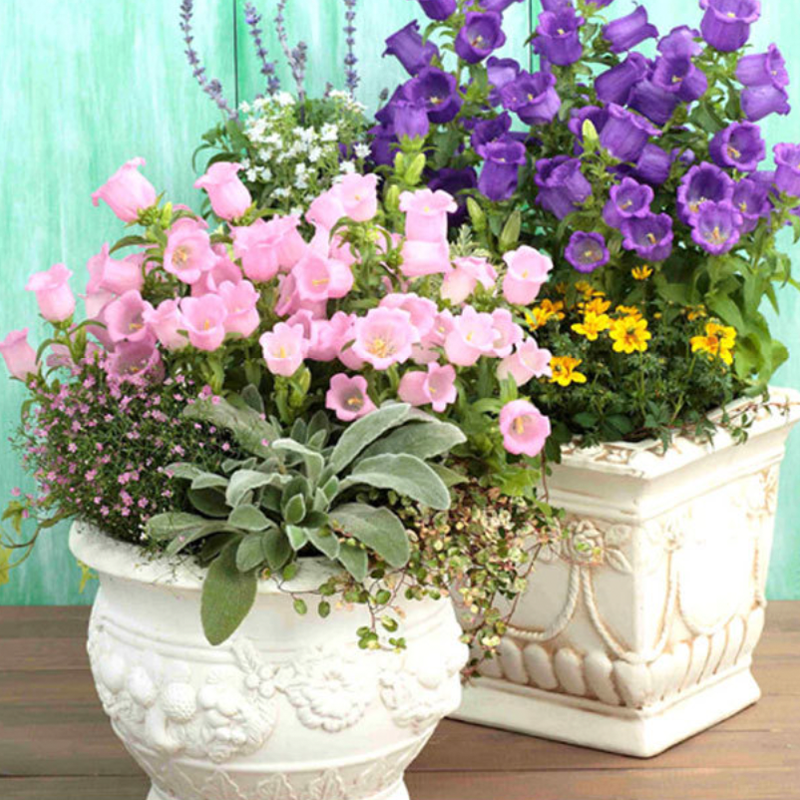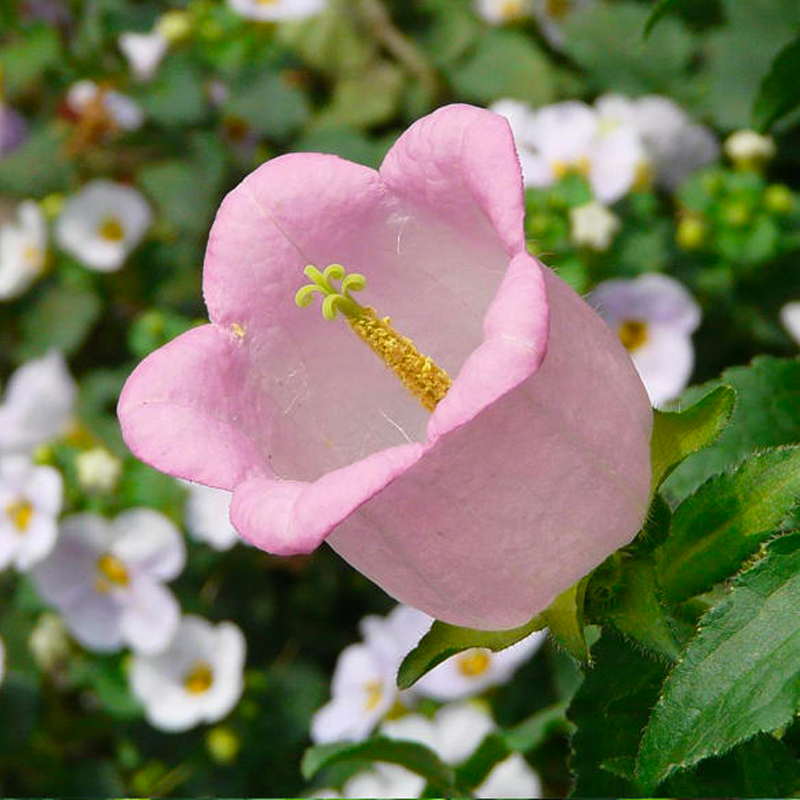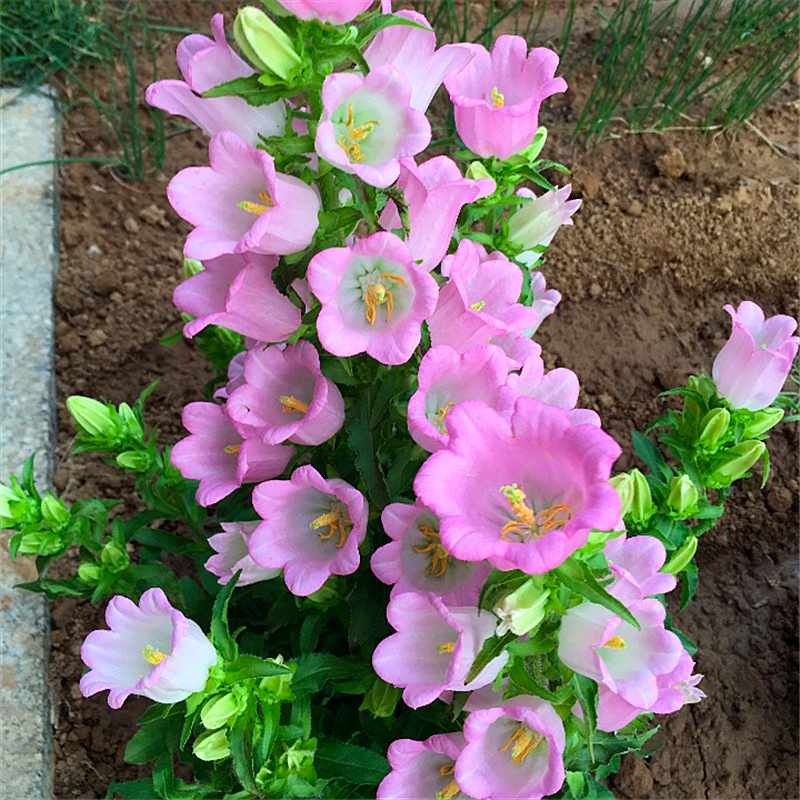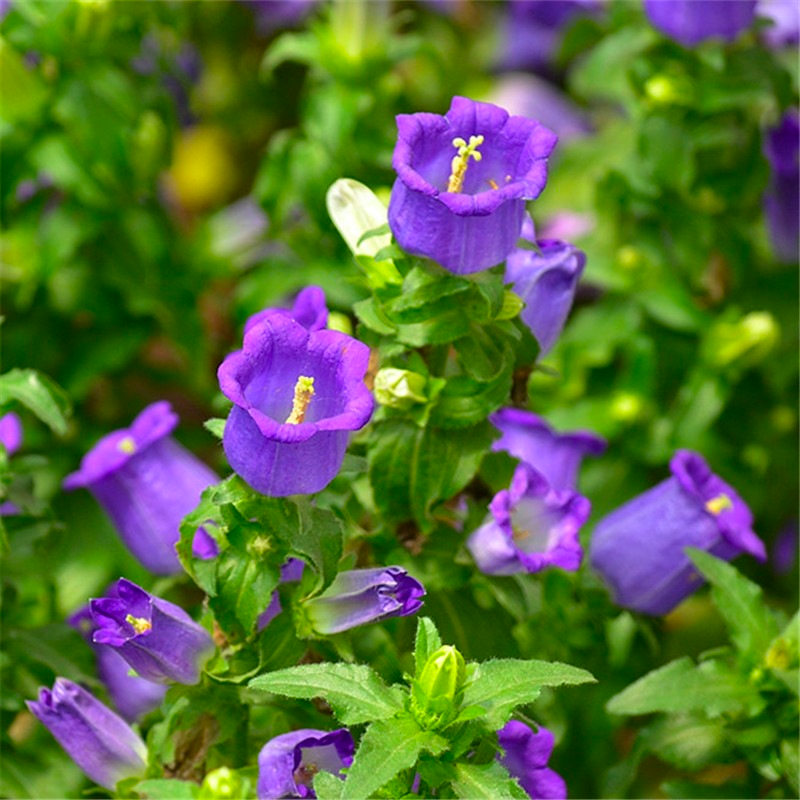
USDA Zones: 3 - 8
Height: 8 inches
Bloom Season: Summer to fall
Soil Type: Moist, well-drained, pH 5.8 - 6.8
Deer Resistant: Yes
Temperature: 70F
Average Germ Time: 14 - 28 days
Light Required: Yes
Depth: Do not cover the seed but tightly press into the soil
Sowing Rate: Approximately 5000 seeds covers 100 square feet or 3 - 4 seeds per plant
Moisture: Keep moist until germination
Plant Spacing: 10 inches

Seeds germinate in 14-21 days. Surface sow seeds and very lightly press them into the soil or cover with a super thin layer of vermiculite or fine potting soil, as the seeds require light in order to germinate. Start seeds indoors in spring or directly sow them in the garden. Ideal germination temperature is 72-75 F.
FAQS
01
When to Plant Canterbury Bells Seeds
Start early in the season, as soon as the threat of frost has passed. Canterbury Bells can also be started indoors, 4-6 weeks before the final frost date.
02
Where to Plant Canterbury Bells Seeds
Canterbury Bells prefer full sun, though can be tolerant of partial shade, and do best in mild temperatures. In warmer climate, ensure these receive plenty of afternoon shade. These seeds do best in fertile, moist, well-draining soil.
03
How to Plant Canterbury Bells Seeds
Sow seeds directly onto the surface of the soil, and firmly compress. Leave seeds uncovered, as they require sunlight to germinate.
05
How to Care for Canterbury Bells
As a perennial, the first season, Canterbury Bells will only produce green foliage. It is encouraged that you overwinter this growth beneath a layer of mulch. During flowering seasons, fertilize every 1-2 months to ensure strong production. Deadheading can also encourage reblooming of Canterbury bells, though it's encouraged to leave some flower heads remaining, so it can naturally reseed.
06
Do Canterbury bells come back?
07
Do Canterbury bells spread?
What are Canterbury Bells? Canterbury bells (Campanula medium), also known as Cups and Saucers, are biennial flowering plants that are native to Southern Europe. The plants spread to the rest of Europe where they have naturalized because they readily self-sow.
08
Can Canterbury bells survive winter?
Overwintering. It's best to grow Canterbury bells indoors for their first year to be well-prepared for winter. You can do so by using a thick layer of mulch and planting in the spring. Water very lightly during frosts.
11
How do I get my Canterbury bells to bloom for the first year?
12
Do bell flowers spread?
13
Do bell flowers bloom all summer?

14
Are Canterbury bells deer resistant?
15
Do bell flowers attract bees?
USDA Zones: 3 - 8
Height: 8 inches
Bloom Season: Summer to fall
Soil Type: Moist, well-drained, pH 5.8 - 6.8
Deer Resistant: Yes
Temperature: 70F
Average Germ Time: 14 - 28 days
Light Required: Yes
Depth: Do not cover the seed but tightly press into the soil
Sowing Rate: Approximately 5000 seeds covers 100 square feet or 3 - 4 seeds per plant
Moisture: Keep moist until germination
Plant Spacing: 10 inches

Seeds germinate in 14-21 days. Surface sow seeds and very lightly press them into the soil or cover with a super thin layer of vermiculite or fine potting soil, as the seeds require light in order to germinate. Start seeds indoors in spring or directly sow them in the garden. Ideal germination temperature is 72-75 F.
FAQS
01
When to Plant Canterbury Bells Seeds
Start early in the season, as soon as the threat of frost has passed. Canterbury Bells can also be started indoors, 4-6 weeks before the final frost date.
02
Where to Plant Canterbury Bells Seeds
Canterbury Bells prefer full sun, though can be tolerant of partial shade, and do best in mild temperatures. In warmer climate, ensure these receive plenty of afternoon shade. These seeds do best in fertile, moist, well-draining soil.
03
How to Plant Canterbury Bells Seeds
Sow seeds directly onto the surface of the soil, and firmly compress. Leave seeds uncovered, as they require sunlight to germinate.
05
How to Care for Canterbury Bells
As a perennial, the first season, Canterbury Bells will only produce green foliage. It is encouraged that you overwinter this growth beneath a layer of mulch. During flowering seasons, fertilize every 1-2 months to ensure strong production. Deadheading can also encourage reblooming of Canterbury bells, though it's encouraged to leave some flower heads remaining, so it can naturally reseed.
06
Do Canterbury bells come back?
07
Do Canterbury bells spread?
What are Canterbury Bells? Canterbury bells (Campanula medium), also known as Cups and Saucers, are biennial flowering plants that are native to Southern Europe. The plants spread to the rest of Europe where they have naturalized because they readily self-sow.
08
Can Canterbury bells survive winter?
Overwintering. It's best to grow Canterbury bells indoors for their first year to be well-prepared for winter. You can do so by using a thick layer of mulch and planting in the spring. Water very lightly during frosts.
11
How do I get my Canterbury bells to bloom for the first year?
12
Do bell flowers spread?
13
Do bell flowers bloom all summer?














